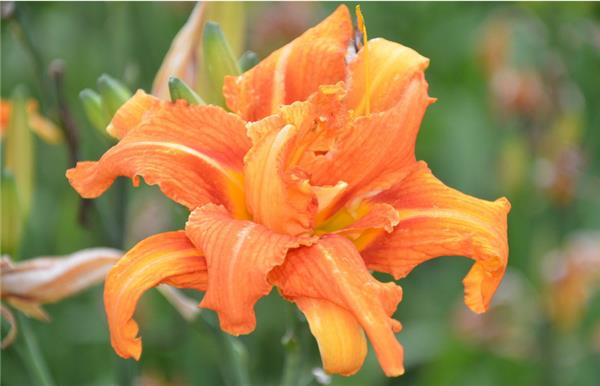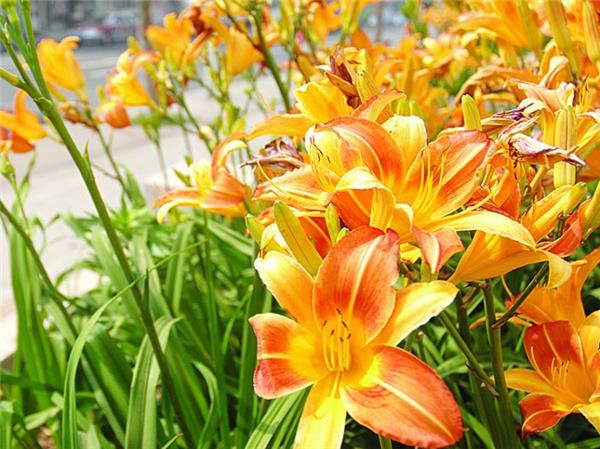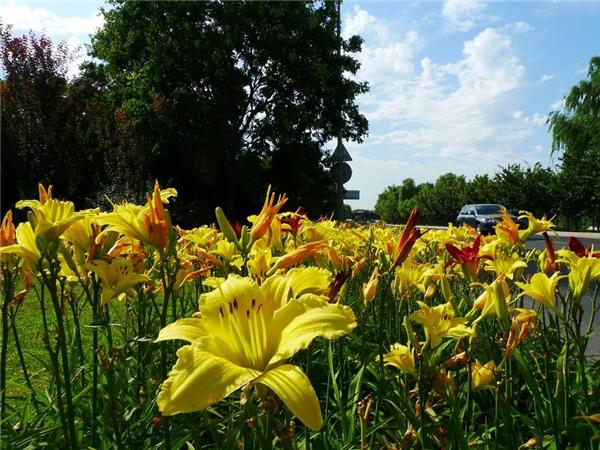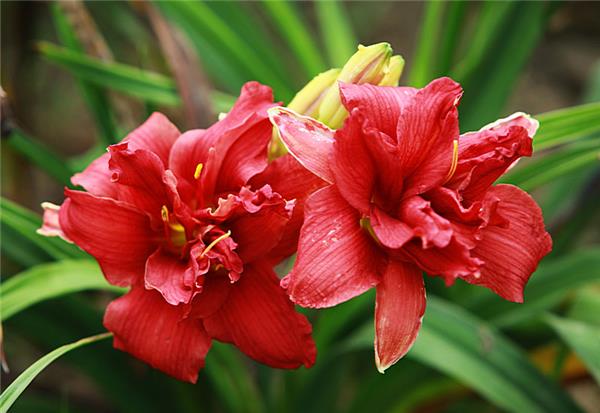[cultivation of Hemerocallis] how to grow Hemerocallis
The price of gold baby daylily is not expensive, generally in 0.15 yuan a tree, there are two hairs more than one. The planting techniques of Hemerocallis fulva L. were discussed from planting, fertilizing, removing residual leaves and propagating methods. What is the planting method of large flower daylily?
Cultivation Techniques of Hemerocallis fulva L.
The cultivation management is simple and extensive, the plant spacing is about 0.5×1 meter, and 3~5 plants are planted in each hole. Apply sufficient base fertilizer before planting. Due to its strong adaptability, Hemerocallis fulva can be planted almost everywhere, and its growth can be continuously expanded year after year, but it should be matched according to plant height and flower color when planting in the garden to improve the viewing effect.

cultivation points
Love warm and humid environments. The soil is better with a little viscosity. It can be cultivated in fields, ditches, houses and other places. Plant division and propagation. From October to November, after the aboveground part withers or before the plants sprout in spring, the whole plants are dug up and divided into clusters every 2 or 3 times. Before planting, open holes according to row and plant spacing of 40cm, hole depth of 17~20cm, plant a clump in each hole, root should be paved on all sides, covered with soil and compacted. Watering or irrigation of human and animal waste water. From the second year onwards, intertillage weeding and topdressing are carried out three times a year, the first time at seedling emergence in March, the second time before flowering in June, and the third time after seedling fall in October. After each intertillage weeding, human and animal manure water is applied.
3. The cultivation and management of Hemerocallis fulva has strong ability to separate sins, and the plant spacing must be maintained at 30 cm ×40 cm when planting. After planting, seedling stage should be timely intertill weeding. Intertillage at seedling stage should be shallow rather than deep, and intertillage should be deepened with the increase of seedling age. The double purpose of weeding and drought prevention can be achieved by shallow loosening before spring seedlings emerge and shallow hoeing three or four times after emergence. Intertillage weeding should be carried out when the soil moisture is moderate and stopped after the leaves cover the land. Remove weeds in the field of daylily in time. If weeds overgrow, it is easy to cause diseases and insect pests, affecting the growth and appearance of daylily. After flowering, cut off the flowering stems from the ground and remove the dead leaves at the base of the plant cluster in time.

4. According to the biological characteristics of Hemerocallis fulva, its root system is issued from the shortened stem node, with the characteristics of from bottom to top, one layer of roots per year, and the position moving up year by year. When Hemerocallis fulva enters the flowering peak, the root system grows very well. If the soil is cultivated, the root system absorption function and drought resistance ability will be greatly weakened, so that the flowering amount will decrease significantly. Therefore, it is one of the important measures that can not be ignored to cultivate Hemerocallis fulva in autumn. The specific method is: first cut off the above-ground part of the daylily, and then apply sufficient autumn fertilizer according to the plan, at the same time, pick fertile pond mud, river mud and other mud fertilizer, heap and apply it to the plant cluster and spread between rows, thicken the soil layer, and improve the soil quality. Before the spring seedlings germinate, rake the soil at the top of the cluster and cultivate it around the cluster. Note that guest soil cultivation is only suitable for Hemerocallis fulva after flowering, and young plants should not be cultivated.

pest control
The main diseases of daylily are rust, leaf spot and leaf blight; pests are aphids, snails, scarabs and red spiders.
1. Disease control Rust, leaf spot and leaf blight are diseases that Hemerocallis fulva is prone to. Rust is a fungal disease, which is the main disease in the middle and late stages of Hemerocallis fulva. It begins to occur in early May, is most serious in June and July, and gradually stops after October, harming leaves and flower moss. The leaves initially produce a small amount of yellow powdery spots, which gradually spread to the whole leaf, so that the whole plant dies. 25% triadimefon wettable powder 200 times or 65% zineb 500 times spray control can be sprayed when the disease occurs. Leaf spot, caused by Fusarium, is the main disease in seedling stage of Hemerocallis fulva. It begins to occur from the end of March to the beginning of April, and its peak is from the middle of April to the middle and late of May. Bordeaux mixture or stone sulfur mixture can be sprayed for control. Leaf blight is caused by a pathogenic fungus of the genus Echinosporium, which is a seedling disease following leaf spot. Generally, the disease begins in early May and is most serious in early and middle June, mainly harming leaves and flowers and moss. The disease starts from seedlings, and the middle edge of the leaves initially produces water-stained spots and then gradually spreads up and down, forming brown stripes, and finally to gray, and when it is serious, the whole leaf dies. 50% carbendazim 600 times to 800 times solution spray or zinc 600 times solution spray, can also spray bordeaux mixture before and after Qingming to control.
2. Pest control The main pests of Hemerocallis fulva are red spiders, Indian tail aphids and snails.

For the Indian tail aphid, the control methods are as follows: eliminating weeds, cutting off residual branches and dead leaves, especially the leaves with insects; trapping and killing winged aphids with yellow thin plastic plates; paying attention to protecting natural enemies, such as ladybugs and lacewings. When the number of natural enemies is large, try to use broad-spectrum pesticides as little as possible, and choose suitable biological pesticides, such as spraying 800 times to 1000 times of 1.2% Kuyan EC; spray in time when the occurrence amount is large, spray one of 2.5% Encide 2500 times to 3000 times, 6% Imidacloprid 3000 times to 4000 times, etc. for foliar spraying, pay attention to safety when spraying.
For spider mites, the methods are as follows: forecast well, check leaf back in time, observe with magnifying glass, and spray medicine as soon as possible when more leaf mites are found to damage. Control early damage, is the key to control late rampant; remove pests branches and weeds, concentrated burning; summer mite quantity is not large, can spray clean water washing; serious pest occurrence, with 1.8% abamectin EC 7000 times to 9000 times uniform spray control; or use 15% pyridaben EC 2500 times to 3000 times have good control effect. Avoid killing mites with dichlorvos, dichlorvos on mites have the role of stimulating proliferation. Do not use pyrethroid pesticides, which are ineffective against mites; protect natural enemies, such as ladybugs, chrysoppers, etc.
For snails, the method is as follows: eliminating weeds and sprinkling quicklime powder to reduce the breeding ground of snails; sprinkling lime tape on the ground of daylily to poison snails; applying 50 g to 100 g of 6% snail killer granules per 100 square meters. 50 g to 100 g of 6% snail buster granules per 100 m2, mixed with 1.5 kg to 2.5 kg of sand, can also be evenly spread to make snails easily exposed to the agent. Or make poison bait with bean cake powder and corn powder, and apply it to snails in the evening to trap and kill them; artificially capture adult shellfish and young shellfish, or use leaves, weeds, vegetable leaves, etc. as bait piles, snails lurk under the bait piles before dawn, and then concentrate on catching them.
The breeding method of golden baby daylily planting technology:
Available tissue culture, sub-plant propagation methods. The annual reproduction coefficient of Hemerocallis chinensis is 1∶6, and the fertile soil can reach 1∶10. The ramets can be rationed during dormancy. Before the beginning of February in Jiangsu and Zhejiang provinces, the dense clusters will be cut open, each cluster with two or three buds, re-planted, planting the same year will bloom. Golden Hemerocallis is a perennial herb of Hemerocallis genus of Liliaceae. It is the only multi-seasonal flowering variety introduced from North America. The golden baby daylily leaves are bright green; the color is golden, and the group viewing effect is good. Mainly used as ground cover plants in landscaping, flower beds and flower borders can also be arranged. The plant of golden baby daylily is clustered, the natural height is 30-40cm, which is 1/3 of the plant height of common daylily; the plant sprouts early in spring, the leaf color is bright green; the color is golden, the group viewing effect is good, the flowering lasts from the beginning of May to the middle of October, and the flowering period lasts for half a year. Hemerocallis chinensis has strong cold and drought resistance, barren tolerance and extensive management tolerance. It can survive winter naturally under the condition of minus 20 degrees in winter in northern China. After planting for two years, it can maintain normal growth by natural precipitation. Mainly used as ground cover plants in landscaping, flower beds and flower borders can also be arranged.
For the Indian tail aphid, the control methods are as follows: eliminating weeds, cutting off residual branches and dead leaves, especially the leaves with insects; trapping and killing winged aphids with yellow thin plastic plates; paying attention to protecting natural enemies, such as ladybugs and lacewings. When the number of natural enemies is large, try to use broad-spectrum pesticides as little as possible, and choose suitable biological pesticides, such as spraying 800 times to 1000 times of 1.2% Kuyan EC; spray in time when the occurrence amount is large, spray one of 2.5% Encide 2500 times to 3000 times, 6% Imidacloprid 3000 times to 4000 times, etc. for foliar spraying, pay attention to safety when spraying.
For spider mites, the methods are as follows: forecast well, check leaf back in time, observe with magnifying glass, and spray medicine as soon as possible when more leaf mites are found to damage. Control early damage, is the key to control late rampant; remove pests branches and weeds, concentrated burning; summer mite quantity is not large, can spray clean water washing; serious pest occurrence, with 1.8% abamectin EC 7000 times to 9000 times uniform spray control; or use 15% pyridaben EC 2500 times to 3000 times have good control effect. Avoid killing mites with dichlorvos, dichlorvos on mites have the role of stimulating proliferation. Do not use pyrethroid pesticides, which are ineffective against mites; protect natural enemies, such as ladybugs, chrysoppers, etc.
For snails, the method is as follows: eliminating weeds and sprinkling quicklime powder to reduce the breeding ground of snails; sprinkling lime tape on the ground of daylily to poison snails; applying 50 g to 100 g of 6% snail killer granules per 100 square meters. 50 g to 100 g of 6% snail buster granules per 100 m2, mixed with 1.5 kg to 2.5 kg of sand, can also be evenly spread to make snails easily exposed to the agent. Or make poison bait with bean cake powder and corn powder, and apply it to snails in the evening to trap and kill them; artificially capture adult shellfish and young shellfish, or use leaves, weeds, vegetable leaves, etc. as bait piles, snails lurk under the bait piles before dawn, and then concentrate on catching them.
The breeding method of golden baby daylily planting technology:
Available tissue culture, plant division propagation methods. The annual reproduction coefficient of Hemerocallis chinensis is 1∶6, and the fertile soil can reach 1∶10. The ramets can be rationed during dormancy. Before the beginning of February in Jiangsu and Zhejiang provinces, the dense clusters will be cut open, each cluster with two or three buds, re-planted, planting the same year will bloom. Golden Hemerocallis is a perennial herb of Hemerocallis genus of Liliaceae. It is the only multi-seasonal flowering variety introduced from North America. The golden baby daylily leaves are bright green; the color is golden, and the group viewing effect is good. Mainly used as ground cover plants in landscaping, flower beds and flower borders can also be arranged. The plant of golden baby daylily is clustered, the natural height is 30-40cm, which is 1/3 of the plant height of common daylily; the plant sprouts early in spring, the leaf color is bright green; the color is golden, the group viewing effect is good, the flowering lasts from the beginning of May to the middle of October, and the flowering period lasts for half a year. Hemerocallis chinensis has strong cold and drought resistance, barren tolerance and extensive management tolerance. It can survive winter naturally under the condition of minus 20 degrees in winter in northern China. After planting for two years, it can maintain normal growth by natural precipitation. Mainly used as ground cover plants in landscaping, flower beds and flower borders can also be arranged.
- Prev

[how to grow white chrysanthemum] the planting method of white crystal chrysanthemum
[how to grow white chrysanthemum] the planting method of white crystal chrysanthemum
- Next

[planting method of Jasper Flower] how to grow Jasper Flower
[planting method of Jasper Flower] how to grow Jasper Flower
Related
- Wuhan Hospital Iron Tree Blooming Result Was Instantly Frightened by the Gardener Master
- Which variety of camellia is the most fragrant and best? Which one do you like best?
- What is the small blue coat, the breeding methods and matters needing attention of the succulent plant
- Dormancy time and maintenance management of succulent plants during dormancy
- Minas succulent how to raise, Minas succulent plant pictures
- What are the varieties of winter succulent plants
- How to raise succulent plants in twelve rolls? let's take a look at some experience of breeding twelve rolls.
- Attention should be paid to water control for succulent plants during dormant period (winter and summer)
- Watering experience of twelve rolls of succulent plants
- Techniques for fertilizing succulent plants. An article will let you know how to fertilize succulent plants.

